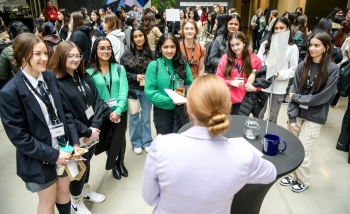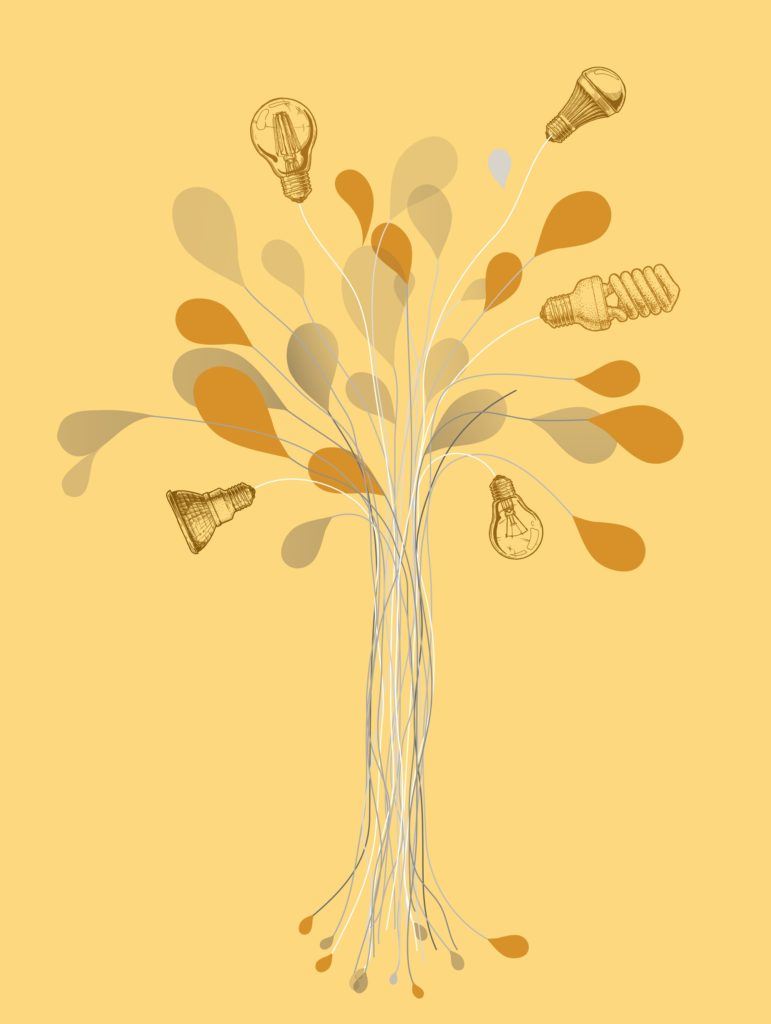Unimaginably powerful quantum computers, unbreakable quantum encryptions, ultraprecise quantum sensors. When we think quantum technology, we think exotic. But though we’re learning to harness the quantum properties of the world in new ways, the deeper truth is that the world has always been quantum.
Even that icon of old-school invention – the light bulb – is a quantum technology. In fact, a tour through the history of the light bulb can double as a tour through the history of science, where small puzzles can lead to big breakthroughs and esoteric little observations can – given enough time – light up the whole world.
Old-school bulbs: The dawn of the quantum world
The first light bulbs were incandescent, which is a physicist’s way of saying that they glow because they are hot, and hot things glow.
In fact, all hot things glow in the same way. Heat something – embers, glass, clay, steel, the little wire filament in a light bulb, anything – to 800°C, and it will glow red. Heat it to 1,100°C, and it will be yellow. 1,300°C, white.
Why should everything at the same temperature emit the same colour light? Physicists love a good phenomenological question, and at the end of the 19th century, this one was all the rage.
The best scientific models of the day said that the energy of the glow should be smeared evenly across all frequencies. This seemed reasonable but resulted in a nonsensical prediction. At the high end of the spectrum, the frequencies are closer together. If each frequency got an equal smear of energy, then the high end of the spectrum would have more energy – and a run-of-the-mill toaster would produce blinding ultraviolet light and deadly X-ray radiation.
That’s not what’s happening – good news for those who like toast, but bad news for 19th century physics. The problem came to be called “the ultraviolet catastrophe.”
Enter Max Planck. Unlike most people who remake science, Planck was no hip young thinker: he was in his forties, with a comfortable position at the University of Berlin and a membership in the Prussian Academy. He was a leading mind in thermodynamics, a branch of physics that defines the relationship between heat and other forms of energy. The ultraviolet catastrophe should have been right up his alley. But, like everyone else, he couldn’t make a model that worked.
Like everyone else, he struggled with it for years. Planck had built a career by clarifying the subtleties of the Second Law of Thermodynamics, which states that entropy always increases. He believed that the Second Law was rigorously true in all circumstances, but not everyone at the time thought so.
Ludwig Boltzmann had developed a model of heat in gases that chopped the gas up into molecules and then considered their average position and velocity using statistics. He’d even written a statistical version of the Second Law, in which entropy increases on average, but may decrease temporarily because of momentary fluctuations. Planck hated it. He wasn’t even convinced that atoms and molecules existed.
So it must have been with desperation that Planck turned to Boltzmann’s method to tackle the ultraviolet catastrophe. As Boltzmann had chopped gas up into atoms, Planck sliced energy up into packets, and he used Boltzmann’s statistical approach to calculate how small these packets could be. It turned out that they did, in fact, have a minimum size.
This was – and is – the solution to the ultraviolet catastrophe: energy doesn’t get smeared evenly across all frequencies, because energy isn’t something you can evenly smear. At small scales, it’s lumpy, coming in bits, which Planck dubbed “quanta” – the Latin word for packet. It was the dawn of quantum mechanics.
Every time you flip on an old-school incandescent bulb, you are lighting the bridge between the 19th century and the quantum age.
Fluorescent bulbs: New lines of light
Fluorescent light bulbs embody an entirely different quantum principle: spectral lines. When light passes through a glass prism, it is split into what most of us call a rainbow and scientists call a spectrum. In the early 1800s, a young glassmaker named Joseph von Fraunhofer was studying this effect when he discovered something that would shape the course of science for centuries to come.
The story behind Fraunhofer being around to make his discovery is so unlikely it’s almost a fairy tale. The youngest son of a glassmaking family, Joseph was orphaned when he was just 11. His guardians sold him into a prestigious apprenticeship cutting vases and decorative mirrors. But young Joseph hated it because it wasn’t scientifically interesting and he was not allowed to continue his studies or read his books on optics. That might well have been the end of it – one more talented mind lost to poverty and chance – but for the master glassmaker’s house collapsing... with Joseph inside.
The story goes that Joseph’s rescue was aided by none other than the prince of Bavaria, Maximilian IV. The support of Prince Maximilian allowed the teenager to leave his apprenticeship and buy new tools. Fraunhofer became a researcher, a producer of lenses for telescopes, and an expert in the refraction of light.
To aid his research, Fraunhofer invented a grating that separated colours in a more reliable way than a prism. His aim was to reliably produce the same specific colour so that he could study the way it bent in different kinds and shapes of glass. But what he discovered in his mapping of the colours of sunlight was something brand new: a series of dark lines, spread across the spectrum like a barcode printed over a rainbow. They came to be called the Fraunhofer lines.
Like most glassmakers, Fraunhofer died young, poisoned by the heavy metal toxins of his craft. But Fraunhofer lines did not die with him. They were rigorously studied, and, in 1860, Gustav Kirchhoff and Robert Bunsen finally cracked their secret. They discovered that when light passed through a gas containing, say, iron, the gas absorbed some specific blue and green lights to create black lines in the spectrum. If the same gas was burned, it created lines of those specific colours. Each element had a unique barcode – a unique set of spectral lines.
Suddenly, spectral lines could be used to tell what things were made of. Suddenly, we could study the composition of the Sun! But working out why different elements have different spectral barcodes took another 50 years and a scientific revolution.
In 1913 – almost 100 years after Fraunhofer mapped his lines – Niels Bohr introduced the first quantum model of the atom. In it, electrons made “quantum leaps” from one energy level to another, emitting or absorbing light at certain wavelengths – or colours – as they did so. This handful of distinct energy levels and transitions between them gives each element its unique set of spectral lines.
The barcode, it turns out, is quantum. Which brings us back to fluorescent lighting. Inside a fluorescent light bulb is a source giving off ultraviolet radiation. Coating the inside of the light bulb are phosphors, which can absorb those ultraviolet bits of light, bumping their electrons up several steps to very high energy levels. As the electrons fall back down, they emit a series of different coloured lights, a barcode that when added together happens to look white.
So when you turn on a fluorescent light bulb, you have your hands on another technology that traces its roots to a young and meticulous researcher noticing something odd.
LEDs: Quantum roots and quantum branches
In 1900, Planck proposed that light comes in packets called quanta. In 1905, Einstein defined how electrons can absorb or emit these packets of light via the photoelectric effect. In 1916, Bohr put these two ideas together to create the first quantum model of the atom. The three discoveries, together, are called “the old quantum mechanics.”
As physics was turning itself inside out, so was the western world. World War One raged from 1914 to 1918. One of the soldiers in that war was a French student from an aristocratic family. His name was Louis Victor Pierre Raymond de Broglie, and he would eventually be the seventh Duke de Broglie and a prince of the realm. But when war broke out, he joined the French army and became a wireless operator, stationed at the Eiffel Tower – by then a wireless telegraph transmitter as well as a landmark.
The posting away from the horrors of the trenches was a lucky break for the young Louis – and perhaps for physics. He came to know radio waves and their technical problems intimately. He had the time and connections to read about modern physics and to learn that light could be both a particle and a wave.
De Broglie survived the war and turned to the study of physics. In a groundbreaking doctoral thesis, he asserted that, just as light could have the particle-like properties of matter, matter – specifically electrons – could have the wave-like properties of light.
Matter as wave: it was astonishing, but it was true. The new quantum mechanics was born. After that, things happened fast. There came Dirac and his wave equation; Heisenberg and Schrödinger and their formulations of wave mechanics; then Bloch with his quantum understanding of solids. Bloch’s understanding gave Schottky footing for models of the strange conducting and insulating properties of materials we now call semiconductors.
From there came the engineers (and more physicists), harnessing the quantum properties of semiconductors to make devices in a wave of innovation that went on for decades. One of these devices was the light-emitting diode, or LED.
LED light bulbs – lit, as one might guess, by LEDs – stand at one branch tip of a tall tree of technological innovation, all of it rooted in theoretical physics. The roots, too, branch out and go deep – one can trace them through famous names and obscure ones, through light bulb moments and odd little observations. Nor are light bulbs unique: almost every technology of the last century has its roots in basic research – research with no obvious or immediate benefit.
We know this. But sometimes it’s interesting to think about the history of science that’s at our fingertips when we flip on a light.
About PI
Perimeter Institute is the world’s largest research hub devoted to theoretical physics. The independent Institute was founded in 1999 to foster breakthroughs in the fundamental understanding of our universe, from the smallest particles to the entire cosmos. Research at Perimeter is motivated by the understanding that fundamental science advances human knowledge and catalyzes innovation, and that today’s theoretical physics is tomorrow’s technology. Located in the Region of Waterloo, the not-for-profit Institute is a unique public-private endeavour, including the Governments of Ontario and Canada, that enables cutting-edge research, trains the next generation of scientific pioneers, and shares the power of physics through award-winning educational outreach and public engagement.
You might be interested in



